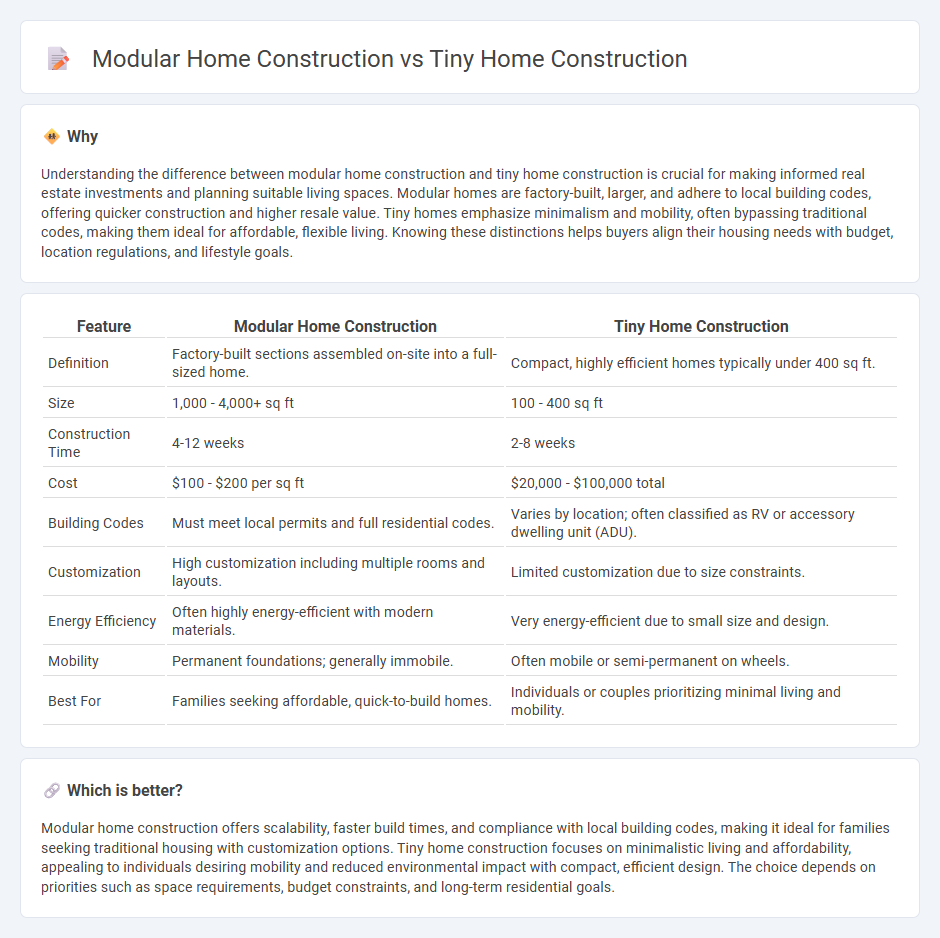
Modular home construction offers faster build times and higher quality control through factory-built sections, making it ideal for larger, customizable residences. Tiny home construction focuses on maximizing limited space with efficient design and portability, appealing to minimalists and those seeking affordable, compact living. Explore the benefits and distinctions between modular and tiny home construction to find the perfect fit for your housing needs.
Why it is important
Understanding the difference between modular home construction and tiny home construction is crucial for making informed real estate investments and planning suitable living spaces. Modular homes are factory-built, larger, and adhere to local building codes, offering quicker construction and higher resale value. Tiny homes emphasize minimalism and mobility, often bypassing traditional codes, making them ideal for affordable, flexible living. Knowing these distinctions helps buyers align their housing needs with budget, location regulations, and lifestyle goals.
Comparison Table
| Feature | Modular Home Construction | Tiny Home Construction |
|---|---|---|
| Definition | Factory-built sections assembled on-site into a full-sized home. | Compact, highly efficient homes typically under 400 sq ft. |
| Size | 1,000 - 4,000+ sq ft | 100 - 400 sq ft |
| Construction Time | 4-12 weeks | 2-8 weeks |
| Cost | $100 - $200 per sq ft | $20,000 - $100,000 total |
| Building Codes | Must meet local permits and full residential codes. | Varies by location; often classified as RV or accessory dwelling unit (ADU). |
| Customization | High customization including multiple rooms and layouts. | Limited customization due to size constraints. |
| Energy Efficiency | Often highly energy-efficient with modern materials. | Very energy-efficient due to small size and design. |
| Mobility | Permanent foundations; generally immobile. | Often mobile or semi-permanent on wheels. |
| Best For | Families seeking affordable, quick-to-build homes. | Individuals or couples prioritizing minimal living and mobility. |
Which is better?
Modular home construction offers scalability, faster build times, and compliance with local building codes, making it ideal for families seeking traditional housing with customization options. Tiny home construction focuses on minimalistic living and affordability, appealing to individuals desiring mobility and reduced environmental impact with compact, efficient design. The choice depends on priorities such as space requirements, budget constraints, and long-term residential goals.
Connection
Modular home construction and tiny home construction are connected through their emphasis on efficiency, cost-effectiveness, and sustainable building practices. Both methods use prefabrication techniques to reduce construction time and minimize waste compared to traditional building approaches. These innovative housing options appeal to homeowners seeking affordable, customizable, and environmentally friendly living spaces.
Key Terms
Building Codes
Building codes for tiny home construction often vary significantly depending on the municipality, with many areas classifying tiny homes as recreational vehicles or accessory structures, which can limit their use as permanent residences. Modular home construction typically adheres to established residential building codes, including the International Residential Code (IRC), ensuring broader compliance and easier financing options. Explore detailed regulations and compliance strategies to determine the best building code approach for your tiny or modular home project.
Foundation Type
Tiny home construction often relies on trailer-mounted foundations for mobility and flexibility, while modular home construction typically uses permanent concrete slab or basement foundations for stability and durability. Foundation choices impact insulation, utility connections, and long-term maintenance requirements in both construction types. Explore more about the foundation differences to determine which suits your lifestyle and building goals best.
Off-Site Fabrication
Off-site fabrication in tiny home construction involves assembling compact, efficient units in controlled environments, minimizing waste and construction time compared to traditional methods. Modular home construction also uses off-site fabrication but focuses on larger, pre-fabricated sections that are transported and assembled on-site, allowing for faster build times and greater customization. Explore detailed comparisons of off-site fabrication techniques to understand which construction method best suits your housing needs.
Source and External Links
Tiny Home Regulations In California - Offers comprehensive information on regulations and costs associated with building tiny homes in California.
Best Tiny Home Builders in California - Lists top builders in California, including KJE Tiny Homes and Alameda Tiny Homes, known for quality and customization.
California Tiny House - Specializes in building customized tiny houses on wheels, offering both pre-built and build-to-order models.
 dowidth.com
dowidth.com